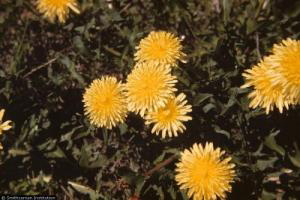The common name "dandelion" comes from dent de lion , French for "lion's tooth," which refers to the teeth on the leaves. The tender young leaves, rich in vitamins and minerals, are used in salads or cooked greens. The delicate yellow flowers can be added to fritters and pancakes, and made into wine and rustic beers. In addition, the leaves are used medicinally; teas made from the leaves are mildly laxative and diuretic, and are also used as a digestive aid.
Photo Credit: © R.A. Howard, USDA-NRCS PLANTS Database. Courtesy of Smithsonian Institution, Dept. of Systematic Biology, Botany.
Taraxacum officinale
Common Name: common dandelion
Other Common Names: blowball, faceclock
Plant Functional Group: Forb
Class > Order > Family: Magnoliopsida > Asterales > Asteraceae
What does the species look like?
Common dandelion is a perennial, herbaceous plant forming a tight rosette growing to 1 to 2.5 feet tall. Its very tiny, yellow flowers cluster tightly into a flowerhead and appear as a single flower. Each tiny flower contains both male and female parts.
Common dandelion is widely distributed and very common, growing in sunny locations, even at high elevations. It tolerates a wide range of site and soil conditions, typically in more moderately moist locations. It is common on lawns, disturbed sites, meadows, rangelands, damp low places, streamsides, and travel corridors.
Where is the species found?
States & Provinces
AB, AK, AL, AR, AZ, BC, CA, CO, CT, DC, DE, FL, GA, HI, IA, ID, IL, IN, KS, KY, LA, MA, MB, MD, ME, MI, MN, MO, MS, MT, NB, NC, ND, NE, NH, NJ, NL, NM, NS, NT, NU, NV, NY, OH, OK, ON, OR, PA, PE, QC, RI, SC, SD, SK, TN, TX, UT, VA, VT, WA, WI, WV, WY, YT
Special Considerations for Observing
If drought seems to be the cause of leaf senescence for a plant, please make a comment about it for that observation.
Which phenophases should I observe?
Do you see...?
Leaves
Initial growth More...
Leaves More...
Flowers
Flowers or flower buds More...
How many flowers and flower buds are present? For species in which individual flowers are clustered in flower heads, spikes or catkins (inflorescences), simply estimate the number of flower heads, spikes or catkins and not the number of individual flowers.
Less than 3 3 to 10 11 to 100 101 to 1,000 More than 1,000
Open flowers More...
What percentage of all fresh flowers (buds plus unopened plus open) on the plant are open? For species in which individual flowers are clustered in flower heads, spikes or catkins (inflorescences), estimate the percentage of all individual flowers that are open.
Less than 5% 5-24% 25-49% 50-74% 75-94% 95% or more
Fruits
Fruits Taraxacum officinale , the fruit is very tiny and seed-like and is crowded into a spent flower head. The seed-like fruit has a tuft of white fluff and changes from yellow-green to light brown, and drops or is blown from the plant after the spent flower head reopens. Do not include empty flower heads that have already dropped all of their fruits.More...
How many fruits are present?
Less than 3 3 to 10 11 to 100 101 to 1,000 More than 1,000
Ripe fruits Taraxacum officinale , a fruit is considered ripe when it has turned light brown and readily drops or is blown from the reopened flower head when touched. Do not include empty flower heads that have already dropped all of their fruits.More...
What percentage of all fruits (unripe plus ripe) on the plant are ripe?
Less than 5% 5-24% 25-49% 50-74% 75-94% 95% or more
Recent fruit or seed drop More...
How many mature fruits have dropped seeds or have completely dropped or been removed from the plant since your last visit?
Less than 3 3 to 10 11 to 100 101 to 1,000 More than 1,000
What do these phenophases look like?
There is currently no photoguide available for this species. If you'd like help us create one, use the guidance document and species template provided here . Then send it via email to education@usanpn.org when it is complete.
